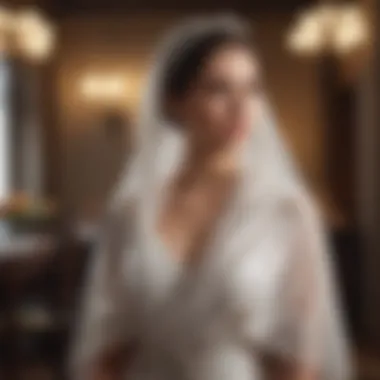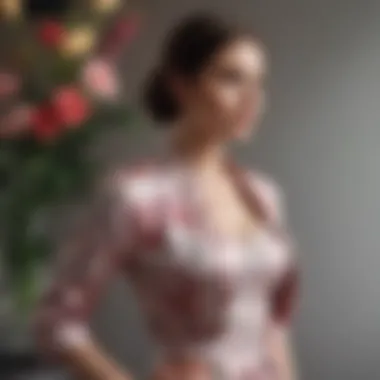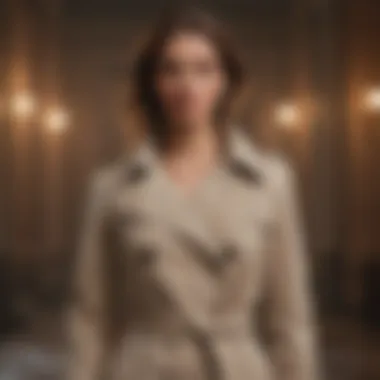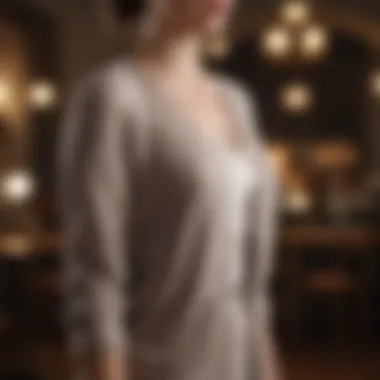Stylish Outerwear Choices for Wedding Guests


Intro
Key Trends
Overview of Current Fashion Trends
In the realm of wedding attire, style preferences have shifted towards versatility and sophistication. Layering has become a favored approach, allowing guests to adapt their look for varying settings and weather conditions. Trending options include tailored blazers, lightweight shawls, and dramatic capes. Each of these choices serves to elevate a wedding guest dress while maintaining ease of movement and comfort.
Popular Outerwear Options:
- Tailored Blazers: Perfect for semi-formal weddings, providing structure and a polished finish.
- Lightweight Shawls: Ideal for outdoor or summer weddings; they add elegance without bulk.
- Dramatic Capes: A statement piece that infuses an element of glam and modernity.
The key is to choose outerwear that can transition seamlessly from the ceremony to the reception, ensuring you remain stylish throughout the event.
Material Considerations
The fabric you select significantly affects the overall vibe of your wedding guest ensemble. For warmer months, breathable materials like chiffon or silk are preferable. These fabrics allow for comfort while exuding a refined appearance. In contrast, wool or heavier blends are suitable for winter weddings, providing warmth without compromising style.
Recommended Fabrics:
- Chiffon: Light and flowy, ideal for warm seasons.
- Silk: Luxurious and adds a touch of elegance.
- Cotton Blend: Offers comfort for casual festivities.
It's essential to coordinate the fabric of your outerwear with that of your dress for a cohesive look.
Color Coordination
Choosing the right colors can harmonize your entire outfit. Consider the wedding's color palette and season when deciding on the hue of your outerwear. Soft pastels work beautifully for spring and summer, while richer, deeper tones are splendid for fall and winter celebrations.
"Coordinating the colors while paying attention to the season can enhance your entire look and avoid clashing with the wedding's theme."
Color Pairings to Consider:
- Pastels: Soft pinks, baby blue for spring.
- Earth Tones: Terracotta, olive green for fall.
- Bold Jewel Tones: Emerald green or sapphire blue for winter.
Practical Tips for Wedding Attire
As you navigate the complexities of wedding attire, keep in mind practical considerations. Check the venue's dress code, climate, and start time. Outdoor weddings may require additional layers due to changing temperatures, while indoor venues might be climate-controlled.
Quick Tips:
- Check the Weather: Be prepared with a light layer if there’s a chance of rain.
- Consider Comfort: Ensure that the outerwear allows movement and does not inhibit your enjoyment of the event.
- Mix and Match: Don’t hesitate to experiment with different combinations to reflect your style.
End
Preface to Wedding Attire
Choosing the right attire for a wedding can be a multifaceted task. As wedding guests, women often find themselves needing to balance personal style with the often complex demands of wedding dress codes. Understanding the nuances of wedding attire is essential. It allows one to express individuality while still respecting the couple’s special day.
The Importance of Outerwear
Outerwear plays a crucial role in wedding attire for several reasons. Primarily, it serves practical functions, such as warmth and coverage, especially during cooler seasons or evening events. Additionally, outerwear can significantly affect the overall appearance of an outfit. A well-chosen piece can elevate a simple dress into a sophisticated ensemble, showcasing the wearer’s fashion sense. Furthermore, outerwear adds layers, allowing for versatility in styling. Different types of outerwear can create varied looks, ensuring that guests have options tailored to their comfort and the formality of the event.
Choosing the Right Dress Style
Selecting the appropriate dress is a fundamental step in planning wedding attire. The style of the dress should complement the overall theme of the wedding and the personal style of the individual. Dresses can vary greatly in cut, fabric, and length, affecting their suitability for different occasions.
When choosing a dress, consider factors such as venue and time of day. For instance, a flowing maxi dress may be ideal for a beach wedding, whereas a structured cocktail dress could be more appropriate for an evening event in a formal hall. The right dress provides a base from which to build the rest of the look.
Ultimately, understanding both the need for effective outerwear and the significance of your dress style establishes a solid foundation for a well-coordinated wedding guest ensemble.


Outerwear Options for Wedding Guest Dresses
When selecting outerwear for wedding guest dresses, the primary aim is to enhance your outfit without overshadowing the dress itself. Outerwear can serve practical purposes such as providing warmth or protection against the weather, while also allowing for personal expression through style. Choosing the right outerwear is paramount in creating a cohesive look for the occasion. There are various types of outerwear available, each with unique characteristics that can elevate your wedding guest ensemble. It’s essential to consider the overall style of your dress, the nature of the event, and your comfort when exploring these options.
Boleros and Shrugs
Boleros and shrugs are both short outerwear options that add a touch of elegance to any wedding guest dress. They typically cover only the shoulders and upper arms, allowing the dress to remain the focal point of the outfit. These styles are particularly beneficial for summer weddings where light coverage is needed without excessive warmth.
Boleros often feature structured designs with or without sleeves, making them a versatile choice. On the other hand, shrugs usually have a more relaxed fit and may incorporate lightweight knits or lace. Both options can effortlessly complement a wide variety of dress types, from sleeveless to strapless.
Cardigans
Cardigans are a flexible and stylish choice for wedding guest attire. Available in numerous styles, lengths, and fabrics, they suit various body shapes and personal preferences. A cardigan can be a practical addition, especially for outdoor or evening weddings when temperatures may drop.
Opting for a fitted cardigan can help to create a sophisticated appearance, especially when paired with a structured dress. Alternatively, looser fits can add a casual element, making them a suitable choice for more relaxed wedding atmospheres. It's recommended to choose cardigans that are made of delicate materials to maintain an elegant overall look.
Jackets
When it comes to jackets, the type can significantly influence the overall vibe of your outfit. A tailored blazer can impart a modern and chic look, perfect for semi-formal or formal weddings. The use of structured jackets can enhance your silhouette and bring an element of sharpness to a softer dress design.
Alternatively, a more casual jacket, like a denim or leather option, can work well for less traditional weddings. However, it’s important to ensure that the style aligns with the formality of the event. A jacket not only provides warmth but can also offer a distinctive flair, making it a practical yet stylish choice for any wedding guest.
Coats
For cooling evenings or winter weddings, coats are essential. A coat adds a layer of warmth and can serve as the outermost garment that defines your look. It's crucial to select a coat that complements the style and color of your wedding guest dress.
Options range from classic trench coats to elegant wool overcoats. The right choice not only provides comfort but can elevate the ensemble. Long coats can elongate the figure, whereas cropped styles may provide a contemporary twist. Choose materials that are appropriate for the season, ensuring both warmth and style.
In summary, the variety of outerwear options available allows for a range of possibilities in creating your wedding guest look. Each type of outerwear offers different benefits, making careful selection essential to achieving a polished appearance.
Material Considerations
Material selection plays a pivotal role in creating a wedding guest outfit that not only looks appealing but also feels comfortable and appropriate for the occasion. The right fabric can enhance your overall appearance and ensure your attire meets the demands of the event’s environment. Various materials offer distinct advantages, and understanding their properties is crucial in making informed choices.
Lightweight Fabrics for Summer
During the summer months, attending a wedding can pose challenges due to heat and humidity. Choosing lightweight fabrics can significantly improve comfort. Materials such as chiffon, linen, and cotton are excellent options. These fabrics allow for breathability which is essential to prevent discomfort in warmer temperatures.
Wearing lightweight outerwear over your dress can also provide an extra layer for sun protection during daytime events. Moreover, fabrics like organza can offer a romantic touch without adding excessive warmth. Opting for lighter colors in these materials can also reflect sunlight, keeping you cool while maintaining a chic look.
Lined Options for Winter
In contrast, winter weddings necessitate different material considerations. Insulated and lined options are vital for warmth. Fabrics like wool, tweed, and heavier silk are highly recommended. A well-lined coat provides not only warmth but also structure to your overall look, complementing the silhouette of your wedding guest dress.
When selecting attire, consider layering techniques to allow for versatility. A stylish wool coat can be layered over your dress, and can easily transition from the ceremony to the reception. Maintaining comfort while exuding elegance should be your goal.
Water-Resistant Materials
Weather unpredictability is a factor to consider in weddings, regardless of the season. Selecting water-resistant materials can be a strategic choice, particularly if the wedding is outdoors. Fabrics such as treated polyester or modern blends designed for weather resistance can prove beneficial. They not only ward off light rain but also maintain a polished appearance.
In instances of inclement weather, options like a sleek trench coat or a tailored rain jacket can serve both style and function. Opting for darker shades in these materials can also be practical, as they conceal potential water spots more effectively.
By prioritizing the right fabrics, you can navigate the complexities of wedding attire more confidently, presenting not only a fashion-forward image but also a practical one.
Color Coordination Strategies
Color coordination is essential when selecting outerwear for a wedding guest dress. Getting colors right can elevate an outfit, enhance personal style, and reflect the formality of the event. Effective color choices can convey confidence and complement not just the dress, but the entire aesthetic you wish to present. Here, we will explore three main strategies: complementary colors, monochromatic looks, and pattern combination techniques.
Complementary Colors
Complementary colors are hues that, when combined, create a striking contrast. They are opposite each other on the color wheel. For instance, if your wedding guest dress is blue, consider an orange bolero or shrug. This technique not only adds dimension but also makes the outfit pop. The use of complementary colors can grab attention without overwhelming the viewer.


When working with complementary schemes, it's helpful to stick to one or two colors at a time. Too many contrasting pieces can create visual chaos. Instead, allow one color to dominate while using the complementary shade as an accent. This will create a more balanced and aesthetically pleasing look.
Another aspect to consider is the shades of each color. For a wedding, softer or pastel versions of complementary colors may be more suitable than their bright counterparts, aligning with the typically elegant ambiance of such events.
Monochromatic Looks
Monochromatic outfits focus on different tones, shades, or tints of a single color. This style fosters an effortlessly sleek appearance. If your guest dress is a light pink, a deeper pink jacket can create an engaging yet harmonious effect. This approach allows for a cohesive, sophisticated vibe.
A monochromatic scheme emphasizes texture and fabric choice over color contrast. For instance, pairing a sleek satin dress with a velvet jacket in the same color can add visual interest through the variation in materials. It is key to incorporate different textures to prevent the outfit from looking flat or monotonous.
Additionally, this method is very forgiving. You won't worry about color clashes, and it allows for easier accessorizing. You can utilize different shades within the same color family for accessories, enhancing the whole ensemble without overwhelming the eye.
Pattern Combination Techniques
Mixing patterns can be tricky but rewarding when done correctly. This design strategy allows for individuality and self-expression. For instance, if your dress is floral, choosing a geometric-patterned jacket can break up the flowery design while still keeping it visually appealing.
To achieve successful pattern combinations, consider the following:
- Scale: Pair large prints with smaller ones for balance.
- Color Harmony: Utilize colors that exist in both patterns to unify the look.
- Proportion: Ensure that patterns do not compete for attention. One should be the focal point while the other acts as support.
In general, patterns should not overwhelm the guest dress but rather enhance it. By following these guidelines, you can confidently experiment with pattern combinations, creating a unique style that stands out while still being appropriate for the occasion.
Always keep in mind the wedding's setting and dress code when choosing your colors and patterns. It is important to maintain a sense of decorum while expressing personal style.
Seasonal Adjustments to Outerwear
When attending weddings, understanding seasonal adjustments to outerwear is crucial for achieving an appropriate and stylish look. Each season presents unique attributes concerning weather, colors, and fabrics. Choosing the right outerwear means considering how these aspects fit with your wedding guest dress. This not only ensures comfort throughout the event but also enhances your overall appearance, making an impactful statement.
Summer Weddings
Summer weddings often bask in warmth and sunlight, making lightweight fabrics a priority. Opt for boleros, capes, or shawls made from breathable materials such as chiffon or lace. These options provide just enough coverage while keeping you cool during warm temperatures. Bright and cheerful colors can complement summer themes, such as soft pastel tones or floral patterns that mirror the seasonal vibe. A light cardigan may also work well if the event transitions into the evening, providing a bit more warmth while maintaining a chic look.
Fall Weddings
Fall weddings usher in cooler temperatures along with rich, warm hues. This season calls for layering techniques. A tailored jacket or a tailored blazer made from thicker fabrics like wool or velvet can add warmth and texture. Deep colors such as burgundy or emerald green can enhance your dress while tying in with autumnal aesthetics. Scarves also emerge as multifunctional accessories that can serve both warmth and individual style, making them an intelligent choice in this transitional season.
Winter Weddings
Winter weddings require careful selection of outerwear due to the cold. Prioritize coats that provide more insulation, such as peacoats or trench coats in classic shades like navy or grey. Fabrics like wool blends and cashmere can offer warmth without compromising elegance. Consider alluding to winter themes by choosing outerwear with subtle embellishments or textured fabric. Ensure that your outerwear is long enough to pair seamlessly with your dress, as this creates a harmonious silhouette appropriate for the season.
Spring Weddings
Spring weddings symbolize renewal with softer weather and blooming flora. Here, lighter outerwear such as tailored vests or light coats can be effective. Fabrics could be cotton or linen, offering a balance between comfort and style. Pastel colors and floral prints are fitting choices that harmonize with the season's spirit. As spring weather can be unpredictable, consider a lightweight, water-resistant jacket that keeps you prepared for sudden showers while enhancing your look.
Investing in suitable seasonal outerwear not only completes your outfit but also ensures you are prepared for any unexpected weather conditions.
Practical Considerations for Wedding Attire
When attending a wedding, practical considerations for your outfit can greatly influence your overall experience. This section explores key elements that intersect style and functionality, ensuring you not only look good but feel comfortable throughout the event. Practical attire allows you to engage more fully with the festivities, whether it’s dancing, navigating outdoor settings, or simply enjoying the day without distraction from your clothing.
Comfort vs. Style
Accessibility of Outerwear Options
Accessibility to your outerwear can impact how well you enjoy the wedding. If it's a chilly day, having easy access to your coat or jacket becomes important. Consider options that can be easily put on or taken off. Look for jackets with zippers or cardigans that you can gracefully drape over your shoulders. Aim to choose styles that work well for quick layering without much fuss. This consideration becomes more significant for evening weddings when temperatures can drop unexpectedly, so planning ahead will ensure you are prepared.
Layering Techniques
Effective layering techniques can add depth to your wedding outfit while providing the necessary warmth or coverage when needed. Here are some tips to layer proficiently:


- Start with a Base Layer: A lightweight dress complements a heavier outer layer well.
- Mix Fabrics Wisely: Combining different materials can create visual interest. For instance, pairing a structured blazer with a flowy dress works harmoniously.
- Accessorize Thoughtfully: Scarves or shawls can be stylish yet functional. They also allow for easy removal if you become too warm.
In the end, layering is not just about added warmth; it's about style adaptability. Choosing outerwear that can transition smoothly between different parts of the event helps keep your style intact without being hindered by practicality.
Remember: Fashion should enhance your enjoyment of the occasion, not detract from it.
Cultural and Regional Considerations
Understanding cultural and regional considerations is crucial when selecting attire for a wedding. These factors dictate not only what is considered appropriate but also how to align one's outerwear choices with the expectations of the event. Each culture has its own customs that influence fashion, especially during significant events like weddings. Ignoring these elements can lead to misunderstandings or even unintentional offense.
Understanding Dress Codes
Dress codes are a fundamental aspect of wedding attire. They signal the formality of the event and guide guests on how to choose their outfits. Some common dress codes include formal, semi-formal, cocktail, and casual. Each code comes with its own expectations for outerwear, as well. For instance, a formal wedding might necessitate a tailored evening coat or a sophisticated wrap, while a casual gathering might allow for lighter, more relaxed options.
Besides general dress codes, it's essential to recognize invitations often contain subtle cues about the venue and overall vibe of the wedding. For example, a beach wedding may suggest lighter fabrics and more breathable materials, as opposed to an indoor ballroom affair. Understanding these nuances ensures an appropriate and respectful appearance.
Adapting to Local Customs
Local customs can greatly affect fashion choices at weddings. Regions may have specific traditions that detail what is acceptable to wear. In some cultures, particular colors or styles are reserved for certain family members, while others may have specific rituals involving clothing.
For instance, in certain Asian weddings, red is a popular color for guests because it symbolizes good fortune. Contrarily, wearing white at a Western wedding might be viewed as imprudent or disrespectful since that color is traditionally reserved for the bride.
Being attentive to local customs not only demonstrates respect but also enhances the overall celebratory environment. Guests who adapt their attire accordingly often find themselves more accepted within the gathering, fostering a sense of shared experience and cultural appreciation.
Accessories to Enhance the Look
Accessories play a vital role in completing any outfit, and this is particularly true when dressing for a wedding. The right accessories can elevate a basic wedding guest dress, adding personal style and sophistication. They help to create a cohesive look and can reflect individual tastes. In the context of wedding attire, accessories not only contribute to a polished appearance but also address functionality.
Choosing the right accessories involves understanding their purpose and how they fit into the overall ensemble. Each accessory should complement the dress while serving a specific function.
Choosing the Right Footwear
Footwear can make or break an outfit. For a wedding guest dress, it is essential to select shoes that are as stylish as they are comfortable. Consider the venue and the season when choosing. A pair of elegant heels may pair well with a formal dress at an indoor event, whereas stylish flats could be more appropriate for an outdoor ceremony.
Different styles of shoes can alter the overall vibe. For example, pointed-toe pumps or strappy sandals can convey sophistication, while ankle boots might lend a more relaxed or edgy feel. Remember that weddings often require extended periods of standing or dancing. Opt for footwear that not only enhances the dress but also ensures comfort throughout the event.
Handbags and Clutches
A handbag or clutch is one of the most practical accessories to consider. When selecting a bag, size matters. It should be large enough to hold essentials like a phone, makeup, and other personal items, but small enough to maintain a sleek profile.
Choose designs that complement the dress color or fabric. Metallic or embellished clutches can add a touch of glamour, while simpler bags provide a more understated look. Materials also matter; for instance, a satin or silk bag can enhance the elegance of a formal dress, whereas a chic leather handbag can suit a more casual ensemble.
Jewelry Considerations
Jewelry serves as an essential finishing touch and can significantly influence the mood of your outfit. The key is balance; if your dress is already patterned or detailed, opt for simpler jewelry pieces. Conversely, a solid colored dress allows for bolder choices.
Consider the neckline of your dress when selecting necklaces. A strapless or off-shoulder neckline pairs beautifully with statement necklaces, while a high neckline may benefit from stud earrings or subtle bracelets. Always ensure that your jewelry choices align with the overall aesthetic you aim to achieve. Also, factor in the materials to avoid clashes—gold, silver, and other metals should harmonize with one another.
Accessorizing thoughtfully can transform a dress from ordinary to spectacular.
In summary, accessories can greatly enhance the overall appearance of a wedding guest dress. From shoes to handbags and jewelry, each piece must be chosen with care to reflect personal style while ensuring practicality and comfort.
Ending of Style Considerations
When considering the outerwear options, one must assess how well they align with the chosen wedding guest dress. The right outerwear can extend the wearability of the dress across seasons and contexts. For example, during a summer wedding, opting for a light cardigan or a stylish bolero can provide just enough coverage without sacrificing comfort. In contrast, winter weddings necessitate more substantial coats or jackets that not only keep warm but also reflect the elegance of the occasion.
Moreover, color coordination plays a crucial role in achieving a cohesive appearance. Selecting outerwear that complements the dress color, whether through a harmonious palette or striking contrasts, can elevate the outfit immensely. Each layer contributes to the visual narrative one wishes to convey, ensuring that every detail reinforces personal style while respecting the wedding's thematic elements.
Practicality is also a central theme. Comfort should never be allowed to bow beneath the weight of style. Women must consider mobility and ease of access when choosing their outerwear. In moments when layered clothing becomes cumbersome, the allure of the dress can quickly diminish. Therefore, understanding the balance between comfort and aesthetics leads to a deeper satisfaction with the overall look.
Key takeaway: Invest time in choosing the right outerwear as it significantly impacts not just the comfort but the style and coordination of your wedding guest outfit.
Final Thoughts on Wedding Attire
Each type of outerwear discussed—be it jackets, cardigans, or coats—holds a functional as well as a stylistic purpose. The knowledge gained from this guide equips readers to approach wedding attire with confidence and clarity. Women of all ages should feel empowered to express their individuality while remaining mindful of the event's nature and expectations.
As one deliberates on their final outfit selection, remember that elegance often blooms from subtlety and thoughtful detailing. Confidence thrives when a look feels both comfortable and chic. By integrating the insights outlined in this article into the decision-making process, one will undoubtedly achieve a well-rounded and sophisticated wedding guest appearance.



